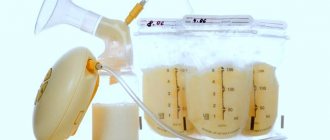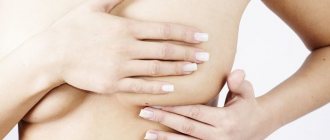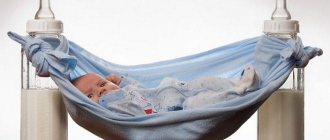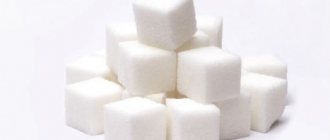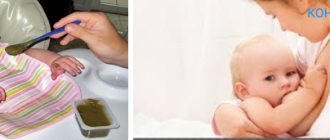The popular dish of Japanese cuisine has long been no longer considered exotic, and for many girls it is a pleasant and tasty component of everyday life. But is it possible to eat rolls and sushi while breastfeeding, or is it better to abstain from these dishes during such an important period of life?
With the birth of a baby, a woman's life undergoes a number of changes. Why are we lying: literally everything changes! Some bad habits and taste preferences are forced to be forgotten, but what can you do for the health of your beloved baby.
Many nursing mothers adhere to a strict diet when feeding their baby, but is it worth denying yourself all the joys of life? Let's look at the gastronomic pleasure loved by many: are sushi and rolls allowed while breastfeeding?
Sushi and rolls - studying the composition features
Sushi and rolls differ in preparation technique and composition.
First, let’s determine how sushi and rolls differ. Sushi is an appetizer consisting of a base of rice and vinegar, on which a thin layer of raw fish or caviar is placed. Depending on the variety, it may also contain dried nori seaweed or edible sheets of rice paper. Rolls are cut into pieces made from nori, rice, fish, avocado or cucumber, omelette, cream cheese and many other ingredients. The composition of rolls is much more varied than sushi; they are more in demand among Russian consumers. Rolls that are subjected to heat treatment - deep-frying or baking - are also popular. In everyday use, rolls are often called sushi, without implying any difference in the technique of preparing these products.
The calorie content of a dish directly depends on the method of preparation and composition. The most high-calorie rolls are tempura rolls, which are fried in oil and contain a lot of fat. The presence of mayonnaise in the composition negatively affects the beneficial properties of the product and increases calorie content. Often cucumber or avocado is added to the composition. Cucumber has minimal calorie content, but its chemical composition is significantly inferior to the components of avocado. The calorie content of rolls can differ by more than 2 times, so if you are striving for slimness, you should not overuse rolls with the above ingredients.
Doctors have different opinions regarding the appropriateness of sushi and rolls in the diet of a nursing mother. On the one hand, the main components of the dish are healthy and can enrich the composition of breast milk with vitamins and minerals. On the other hand, low-quality, too spicy, salty or allergenic ingredients, and raw fish can pose a danger. Russian cafes and delivery services offer sushi and rolls that differ significantly from traditional Japanese cuisine, and not for the better. You can only find real oriental snacks in restaurants, but they are expensive.
Rolls and sushi prepared at home from high-quality ingredients can be useful during breastfeeding and do not cause negative reactions in the baby, but they must be introduced into the diet carefully. Additional spices traditionally served with sushi and rolls require special attention - wasabi and pickled ginger, vinegar used to soak the finished rice. These are spicy seasonings with specific tastes that negatively affect the taste of breast milk. But soy sauce, in which it is customary to dip a snack before putting it in the mouth, contains a lot of useful substances if it is made using traditional technology. At the same time, its quantity should be minimal, since the sauce is too salty, retains liquid in the tissues and can negatively affect the volume of breast milk.
Calorie tables
| Roll | Calorie content per 100 g (Kcal)* |
| Avocado Roll | 105 |
| Roll Alaska | 90 |
| Roll Atsui Maki | 137 |
| Roll Banzai | 143 |
| Roll Beruto daikon | 99 |
| Roll Bonito | 148 |
| Roll Butaniku kimuti | 144 |
| Roll Geisha maki | 158 |
| Roll Jitaku | 148 |
| Roll Dragon Maki | 189 |
| Roll Inari spicy | 123 |
| Roll Kaguwase | 171 |
| Roll Kaji sake | 142 |
| Roll California | 176 |
| Roll Canada | 151 |
| Roll Kani hinata | 124 |
| Roll Kappa Maki | 90 |
| Roll Karui | 46 |
| Roll Kyoto | 155 |
| Roll Kunsei batacon | 174 |
| Roll Manatsubi | 99 |
| Roll Mashiro daikon | 71 |
| Roll Midori sake | 152 |
| Roll Owara | 143 |
| Roll Okinawa | 139 |
| Roll Rainbow | 105 |
| Roll Rock 'n' Roll | 138 |
| Roll with salmon | 116 |
| Roll with cucumber | 80 |
| Roll with eel | 110 |
| Roll Samurai | 120 |
| Roll Supaisu Tempura | 160 |
| Roll Syake | 128 |
| Roll Syake kunsei maki | 146 |
| Roll Syake unagi maki | 150 |
| Roll Tamago maki | 145 |
| Roll Tanuki | 201 |
| Roll Tanuki furai maki | 154 |
| Roll Tokyo | 155 |
| Roll Tori Yasai | 160 |
| Roll Tekka maki | 105 |
| Roll Tempura | 129 |
| Roll Unagi | 173 |
| Roll Unagi | 173 |
| Unagi kani roll | 277 |
| Roll Unagi chizu | 165 |
| Roll Unagi uramaki | 152 |
| Roll Philadelphia | 142 |
| Roll Harumaki | 242 |
| Roll Zucchini maki | 87 |
| Roll Chidori | 163 |
| Roll Ebi kaigan | 120 |
| Sushi | Calorie content 1 piece (Kcal)* |
| With shrimp | 60 |
| With caviar | 39 |
| With salmon | 38 |
| With squid | 22 |
| With eel | 51 |
| With scallop | 24 |
| With an omelette | 50 |
*Approximate calorie content is given; may vary depending on the mass fraction of ingredients
What you should pay attention to?
Each person is individual and perceives food to varying degrees. Can everyone eat rolls while breastfeeding? Unfortunately no. You should try a small amount of this dish and monitor the child’s body’s reaction to it during the day. For example, an allergic reaction to seafood may occur, presented in the form of a rash or peeling. Rice often causes long-term constipation, causing abdominal discomfort. The child will begin to sleep restlessly and will try to pull his legs towards his chest. Many additives, such as ginger, wasabi or soy sauce, can change the taste of milk, causing your child to refuse to drink it.
Is it possible to eat rolls and sushi while breastfeeding?
To prevent sushi and rolls from harming mother and baby, they should be eaten with caution.
The influence of sushi and rolls on lactation and the well-being of mother and baby is individual. The quality of the product is of particular importance - if there is no confidence in the freshness and safety of the ingredients, you should not use it. In any case, you can try the rolls no earlier than the baby turns 3 months old - by this time the functioning of his digestive system will improve, and the likelihood of negative reactions will decrease. Please note that seafood, which is part of most sushi and rolls, are allergens and can cause a rash, redness of the skin, disturbances in stool and digestion, and in rare cases, difficulty breathing.
I won’t eat raw fish even without GW. Only worms and poisoning were not enough. Why not processed? But I wouldn’t order it; it’s better to make it myself. Or in a cafe.
Nataorkha
https://deti.mail.ru/forum/nashi_deti/kormim_grudju/sushi_i_rolly_pri_gv/
definitely - no, you don’t know under what conditions it is prepared, God forbid you catch salmonella and go with your child to the hospital with unclear prognoses
There is only a moment
https://deti.mail.ru/forum/nashi_deti/kormim_grudju/sushi_i_rolly_pri_gv/
I ate rolls for the first time when my son was three months old. Everything was ok! Now we are 10 months into breastfeeding, we eat periodically! But only in a trusted restaurant
nadin27
https://www.u-mama.ru/forum/kids/0–1/148226/index.html
From the time my daughter was 2-3 months old I ordered rolls without fish, just with vegetables + everything else was also delicious... from the age of 10 months I started eating it with all sorts of fish, I allow myself a couple of times a month, because I’m just crazy about them. With both the first and second options, everything was OK, my daughter had no allergies or bowel problems)) But children are different, after all) Try a little to begin with, and choose a less allergenic fish.
Tanyusha
https://www.babyblog.ru/community/post/01medicina/1720040
Benefits of the dish
The components of the dish can be useful during breastfeeding.
The components of sushi and rolls, if their quality is beyond doubt, can bring a lot of benefits to a nursing mother and baby. Let's look at the properties of traditional ingredients allowed during breastfeeding in more detail:
- Rice. This cereal crop is rich in vitamins B, PP, E, minerals - magnesium, phosphorus, selenium, zinc and others. Rice has a positive effect on the health of the digestive system and can enrich breast milk with nutrients.
- Seafood. Red fish, shrimp, caviar, and crab meat are most often added to the dish. These delicacies are rich in phosphorus, vitamin D, fatty acids, zinc and other nutrients necessary for the qualitative physical and intellectual development of the child.
- Nori seaweed. Contains iodine, vitamin B12, calcium, phosphorus and other minerals and vitamins. The components of the product have a beneficial effect on the activity of the thyroid gland, the cardiovascular system, help strengthen bone tissue, and maintain immunity.
- Avocado. Rich in valuable fatty acids and vitamin E to maintain female beauty and regulate the hormonal levels of a nursing woman.
- Soy sauce. Contains amino acids, minerals and vitamins. Prevents the development of cancer, improves blood composition, and slows down aging.
- Cream or cottage cheese. This fermented milk product is distinguished by its high calcium content, which is necessary for a strong skeleton and healthy tooth enamel.
Harm to the product
Raw fish is an undesirable product in the diet of a nursing mother.
Despite the beneficial properties of the main components of sushi and rolls, these snacks can be dangerous for the well-being of mother and baby. Let's list the potentially harmful properties of sushi and rolls:
- Possibility of allergies. Fish and seafood are considered strong allergens. You should not eat sushi and rolls if the mother has ever had an allergy to seafood and the baby is sensitive to new dishes in her diet. Perhaps you should give preference to rolls with chicken or thermally processed fish, fried shrimp, and vegetable fillings.
- Risk of salmonellosis infection. Raw fish is dangerous. In the land of the rising sun, sushi and rolls are prepared from freshly caught fish of noble varieties and there is no doubt about the quality of the product. In our country, frozen fish is available, and the risk of infection with parasites, salmonellosis and other unpleasant infections is quite high. It is also possible that sanitary and hygienic standards are violated in a catering establishment where rolls and sushi are prepared.
- Complex composition. Rolls are a multi-component dish. Your baby may experience digestive problems caused by incompatible ingredients. Sometimes such problems are caused by a specific ingredient, which is difficult to identify in a complex composition.
- Hot spices. Wasabi, vinegar and ginger can negatively affect the taste of breast milk and cause the baby to refuse to feed. In addition, these spices are quite spicy and can cause digestive problems.
- High salt content in soy sauce. This seasoning, despite its beneficial qualities, can cause swelling, stagnation of fluid in the body and a subsequent decrease in the volume of breast milk. There is a risk of running into low-quality sauce made with the use of chemicals that accelerate the fermentation process of soybeans during production, but negatively affect the well-being of mother and baby.
Potential Harm
Like most foods, rolls or sushi behave differently when breastfeeding. In some cases, they are quite dangerous to a woman’s health and harmful to the child’s body. Eg:
- Raw fish can carry a large number of harmful parasites.
- Development of a severe allergy in a newborn to ginger root or fish delicacies.
- An overdose of products with a pronounced taste (wasabi) can affect the quality of mother's milk.
Rules of use
Soy sauce is not contraindicated for breastfeeding, but its amount should be reduced.
If a nursing mother is a fan of sushi and rolls and cannot deny herself such delicacies, it is worth taking precautions so as not to harm the baby. Follow these guidelines:
- choose rolls without raw fish - vegetable, baked, with chicken;
- Avoid or minimize your consumption of wasabi, vinegar and pickled ginger;
- do not eat sushi and rolls if their freshness and quality are in doubt, or if there is an unpleasant alcohol or ammonia smell;
- do not introduce it into the diet before the baby is 3 months old;
- Try a small amount of the product for the first time and monitor your baby’s reaction;
- if a rash, redness of the skin, or indigestion appears, you should avoid sushi and rolls;
- in the absence of a negative reaction in the child, the mother is allowed to consume 4–6 rolls a day, no more than 2 times a week;
- Do not introduce it into the diet if the baby is prone to allergies.
How to cook a healthy dish
Having stuffed your hand, you can make rolls not only tasty, but also original.
If you want to enjoy rolls, prepare a safe version of them with your own hands. This way you can be confident in the safety of the composition. Please note the following recommendations:
- use a minimal amount of vinegar to soak the rice or eliminate it altogether;
- use fried or smoked fish rather than raw;
- You can use omelette, vegetables, heat-treated chicken fillet as filling;
- Vegetarian rolls are the safest;
- do not eat ginger and wasabi;
- use a small amount of soy sauce.
The most popular cheese for making rolls is Philadelphia. It was named after the state in the USA, where its recipe was developed, especially for subsequent addition to an oriental snack. Rolls with salmon, avocado and cheese received the same name. To make rolls at home, you can buy this cheese in the supermarket or replace it with an analogue - curd cheese with a paste-like consistency.
Recipe: rolls with salmon and avocado
Rolls made by yourself can be even tastier than in a restaurant
Ingredients:
- round grain rice 200 g;
- water 500 ml;
- lightly salted smoked salmon 150 g;
- avocado ½ piece;
- cream cheese 100 g;
- nori sheets.
Cooking process
- Soak the rice for 15-20 minutes, then rinse and drain.
- Place the cereal in a saucepan and fill with clean water.
- Cook for about 15 minutes over low heat.
- Turn off the heat and let the rice cool naturally.
- Cut the fish into slices.
- Remove the pit from the avocado, peel and cut into cubes.
- Place a sheet of nori on a bamboo mat.
- Lay out the rice in an even layer (0.5–0.7 cm thick), leaving 2 cm from one edge of the nori, and press down with your palms;
- Place a strip of filling in the center of the sheet: cream cheese, salmon slices and avocado.
- Lifting the edge of the mat away from you, twist the roll tightly.
- Cut the roll into 6-8 pieces.
- Eat by soaking the pieces in soy sauce.
Experts' opinions about the delicacy
Pediatricians helping mothers with newborns and gynecologists observing women after childbirth do not give a clear answer to the question of whether it is worth returning to your favorite dish during lactation. Many factors are important:
- What products were used in the preparation. They must be fresh and the dish must be created under normal conditions. It is best to cook it at home, avoiding going to dubious establishments.
- How does the baby react to the presence of the ingredients in the rolls in the mother’s diet? He may not “notice” changes in diet, but a sharp negative reaction cannot be ruled out.
- How well does a nursing woman feel after eating sushi? A long-term absence of exotic foods in the diet can also lead to digestive disorders and, as a result, suppression of lactation.
- How often does a woman allow herself to eat the delicacy, in what quantity.
Therefore, doctors do not give a single answer to the question of whether a nursing mother can have sushi. This dish is not on the list of essentials during lactation. But there is also no categorical denial of its presence on the table of the baby’s mother.
The positive side of this issue
Japanese dishes always consist of natural products that have a beneficial effect on the human body. Is it possible to use rolls while breastfeeding? Of course. But only if they include the following:
- Rice combined with rice vinegar. You can list for a long time what useful vitamins are contained in these components (magnesium, calcium, phosphorus and many others). They fill the body with the energy necessary for a full existence.
- Pediatricians advise almost all nursing mothers to eat seafood. This is due to the content of protein and unique Omega-3 acids in them. If you regularly use them, your brain function will improve, your immune system will strengthen, and your child will begin to gain weight more actively.
- Specialized nori seaweed is more beneficial for mother than for baby. They will make her feel always in good shape and will have a great impact on her appearance.
- Ginger and soy sauce are “saviors” from the development of inflammatory processes and severe diseases.
- Wasabi is a naturally occurring substance that is essential for preventing tooth decay.
Having studied the positive properties of each substance, it is not difficult to guess that rolls during breastfeeding not only do not cause harm, but can also bring great benefits to the body.
Sources
- https://orebenke.info/posle-rodov/pitanie-kormyashhej-mamy/mozhno-li-rollyi-pri-grudnom-vskarmlivanii.html
- https://BraBook.ru/gv/pitanie/mozhno-li-rolly-pri-grudnom-vskarmlivanii.html
- https://poslerodov.pro/pitanie-kormyashhej-mamy/mozhno-li-rollyi-pri-grudnom-vskarmlivanii.html
- https://fb.ru/article/346584/mojno-li-rollyi-pri-grudnom-vskarmlivanii-kormyaschey-mame
- https://EdaKarapuza.ru/laktaciya/dieta/rolly-pri-grudnom-vskarmlivanii.html
- https://pervyerody.ru/eda/mozhno-li-est-sushi-i-rolly-pri-grudnom-vskarmlivanii-gv.html



